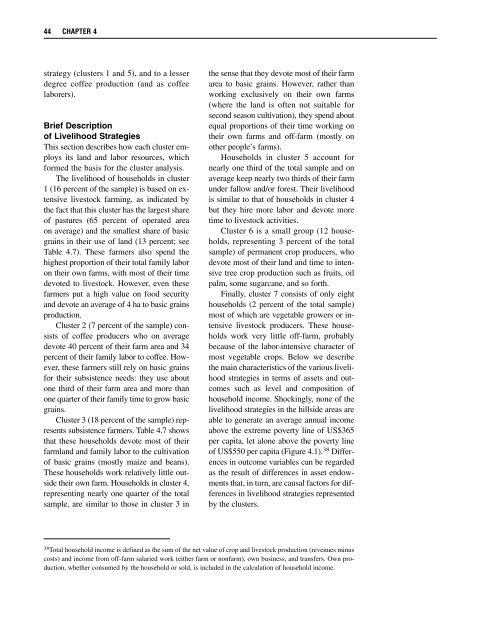Rural Development Policies and Sustainable Land Use in the ...
Rural Development Policies and Sustainable Land Use in the ...
Rural Development Policies and Sustainable Land Use in the ...
You also want an ePaper? Increase the reach of your titles
YUMPU automatically turns print PDFs into web optimized ePapers that Google loves.
44 CHAPTER 4<br />
strategy (clusters 1 <strong>and</strong> 5), <strong>and</strong> to a lesser<br />
degree coffee production (<strong>and</strong> as coffee<br />
laborers).<br />
Brief Description<br />
of Livelihood Strategies<br />
This section describes how each cluster employs<br />
its l<strong>and</strong> <strong>and</strong> labor resources, which<br />
formed <strong>the</strong> basis for <strong>the</strong> cluster analysis.<br />
The livelihood of households <strong>in</strong> cluster<br />
1 (16 percent of <strong>the</strong> sample) is based on extensive<br />
livestock farm<strong>in</strong>g, as <strong>in</strong>dicated by<br />
<strong>the</strong> fact that this cluster has <strong>the</strong> largest share<br />
of pastures (65 percent of operated area<br />
on average) <strong>and</strong> <strong>the</strong> smallest share of basic<br />
gra<strong>in</strong>s <strong>in</strong> <strong>the</strong>ir use of l<strong>and</strong> (13 percent; see<br />
Table 4.7). These farmers also spend <strong>the</strong><br />
highest proportion of <strong>the</strong>ir total family labor<br />
on <strong>the</strong>ir own farms, with most of <strong>the</strong>ir time<br />
devoted to livestock. However, even <strong>the</strong>se<br />
farmers put a high value on food security<br />
<strong>and</strong> devote an average of 4 ha to basic gra<strong>in</strong>s<br />
production.<br />
Cluster 2 (7 percent of <strong>the</strong> sample) consists<br />
of coffee producers who on average<br />
devote 40 percent of <strong>the</strong>ir farm area <strong>and</strong> 34<br />
percent of <strong>the</strong>ir family labor to coffee. However,<br />
<strong>the</strong>se farmers still rely on basic gra<strong>in</strong>s<br />
for <strong>the</strong>ir subsistence needs: <strong>the</strong>y use about<br />
one third of <strong>the</strong>ir farm area <strong>and</strong> more than<br />
one quarter of <strong>the</strong>ir family time to grow basic<br />
gra<strong>in</strong>s.<br />
Cluster 3 (18 percent of <strong>the</strong> sample) represents<br />
subsistence farmers. Table 4.7 shows<br />
that <strong>the</strong>se households devote most of <strong>the</strong>ir<br />
farml<strong>and</strong> <strong>and</strong> family labor to <strong>the</strong> cultivation<br />
of basic gra<strong>in</strong>s (mostly maize <strong>and</strong> beans).<br />
These households work relatively little outside<br />
<strong>the</strong>ir own farm. Households <strong>in</strong> cluster 4,<br />
represent<strong>in</strong>g nearly one quarter of <strong>the</strong> total<br />
sample, are similar to those <strong>in</strong> cluster 3 <strong>in</strong><br />
<strong>the</strong> sense that <strong>the</strong>y devote most of <strong>the</strong>ir farm<br />
area to basic gra<strong>in</strong>s. However, ra<strong>the</strong>r than<br />
work<strong>in</strong>g exclusively on <strong>the</strong>ir own farms<br />
(where <strong>the</strong> l<strong>and</strong> is often not suitable for<br />
second season cultivation), <strong>the</strong>y spend about<br />
equal proportions of <strong>the</strong>ir time work<strong>in</strong>g on<br />
<strong>the</strong>ir own farms <strong>and</strong> off-farm (mostly on<br />
o<strong>the</strong>r people’s farms).<br />
Households <strong>in</strong> cluster 5 account for<br />
nearly one third of <strong>the</strong> total sample <strong>and</strong> on<br />
average keep nearly two thirds of <strong>the</strong>ir farm<br />
under fallow <strong>and</strong>/or forest. Their livelihood<br />
is similar to that of households <strong>in</strong> cluster 4<br />
but <strong>the</strong>y hire more labor <strong>and</strong> devote more<br />
time to livestock activities.<br />
Cluster 6 is a small group (12 households,<br />
represent<strong>in</strong>g 3 percent of <strong>the</strong> total<br />
sample) of permanent crop producers, who<br />
devote most of <strong>the</strong>ir l<strong>and</strong> <strong>and</strong> time to <strong>in</strong>tensive<br />
tree crop production such as fruits, oil<br />
palm, some sugarcane, <strong>and</strong> so forth.<br />
F<strong>in</strong>ally, cluster 7 consists of only eight<br />
households (2 percent of <strong>the</strong> total sample)<br />
most of which are vegetable growers or <strong>in</strong>tensive<br />
livestock producers. These households<br />
work very little off-farm, probably<br />
because of <strong>the</strong> labor-<strong>in</strong>tensive character of<br />
most vegetable crops. Below we describe<br />
<strong>the</strong> ma<strong>in</strong> characteristics of <strong>the</strong> various livelihood<br />
strategies <strong>in</strong> terms of assets <strong>and</strong> outcomes<br />
such as level <strong>and</strong> composition of<br />
household <strong>in</strong>come. Shock<strong>in</strong>gly, none of <strong>the</strong><br />
livelihood strategies <strong>in</strong> <strong>the</strong> hillside areas are<br />
able to generate an average annual <strong>in</strong>come<br />
above <strong>the</strong> extreme poverty l<strong>in</strong>e of US$365<br />
per capita, let alone above <strong>the</strong> poverty l<strong>in</strong>e<br />
of US$550 per capita (Figure 4.1). 38 Differences<br />
<strong>in</strong> outcome variables can be regarded<br />
as <strong>the</strong> result of differences <strong>in</strong> asset endowments<br />
that, <strong>in</strong> turn, are causal factors for differences<br />
<strong>in</strong> livelihood strategies represented<br />
by <strong>the</strong> clusters.<br />
38<br />
Total household <strong>in</strong>come is def<strong>in</strong>ed as <strong>the</strong> sum of <strong>the</strong> net value of crop <strong>and</strong> livestock production (revenues m<strong>in</strong>us<br />
costs) <strong>and</strong> <strong>in</strong>come from off-farm salaried work (ei<strong>the</strong>r farm or nonfarm), own bus<strong>in</strong>ess, <strong>and</strong> transfers. Own production,<br />
whe<strong>the</strong>r consumed by <strong>the</strong> household or sold, is <strong>in</strong>cluded <strong>in</strong> <strong>the</strong> calculation of household <strong>in</strong>come.
















